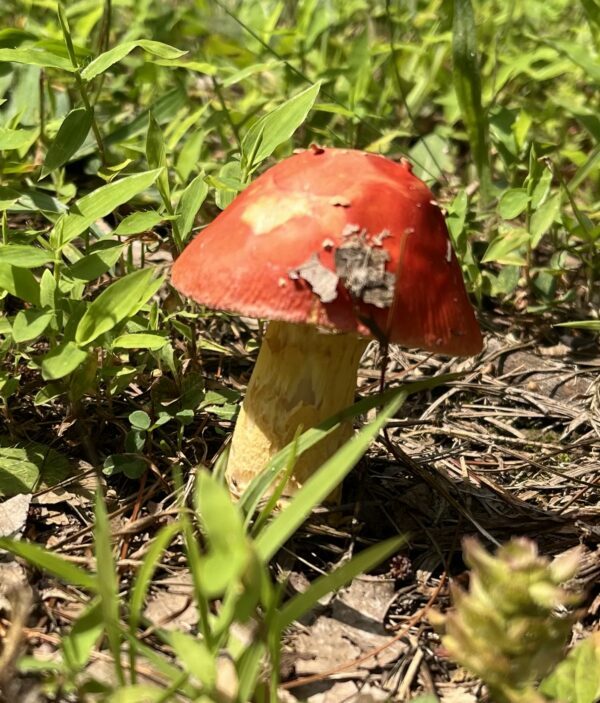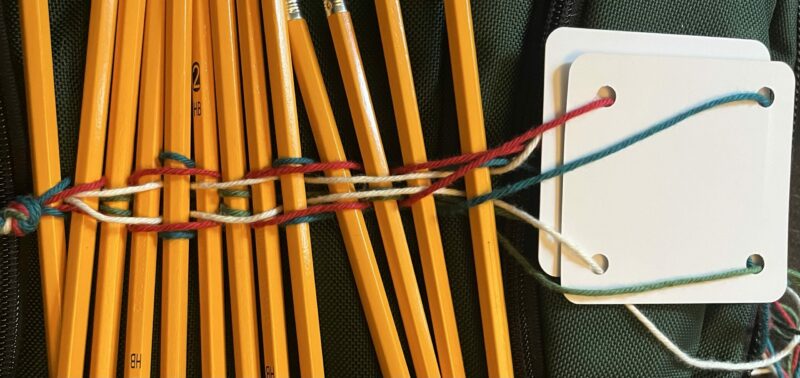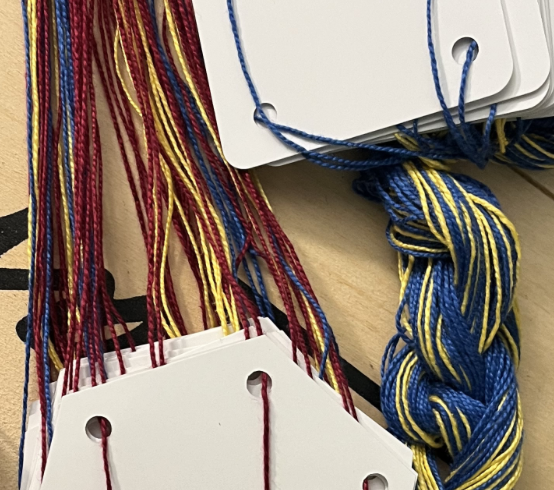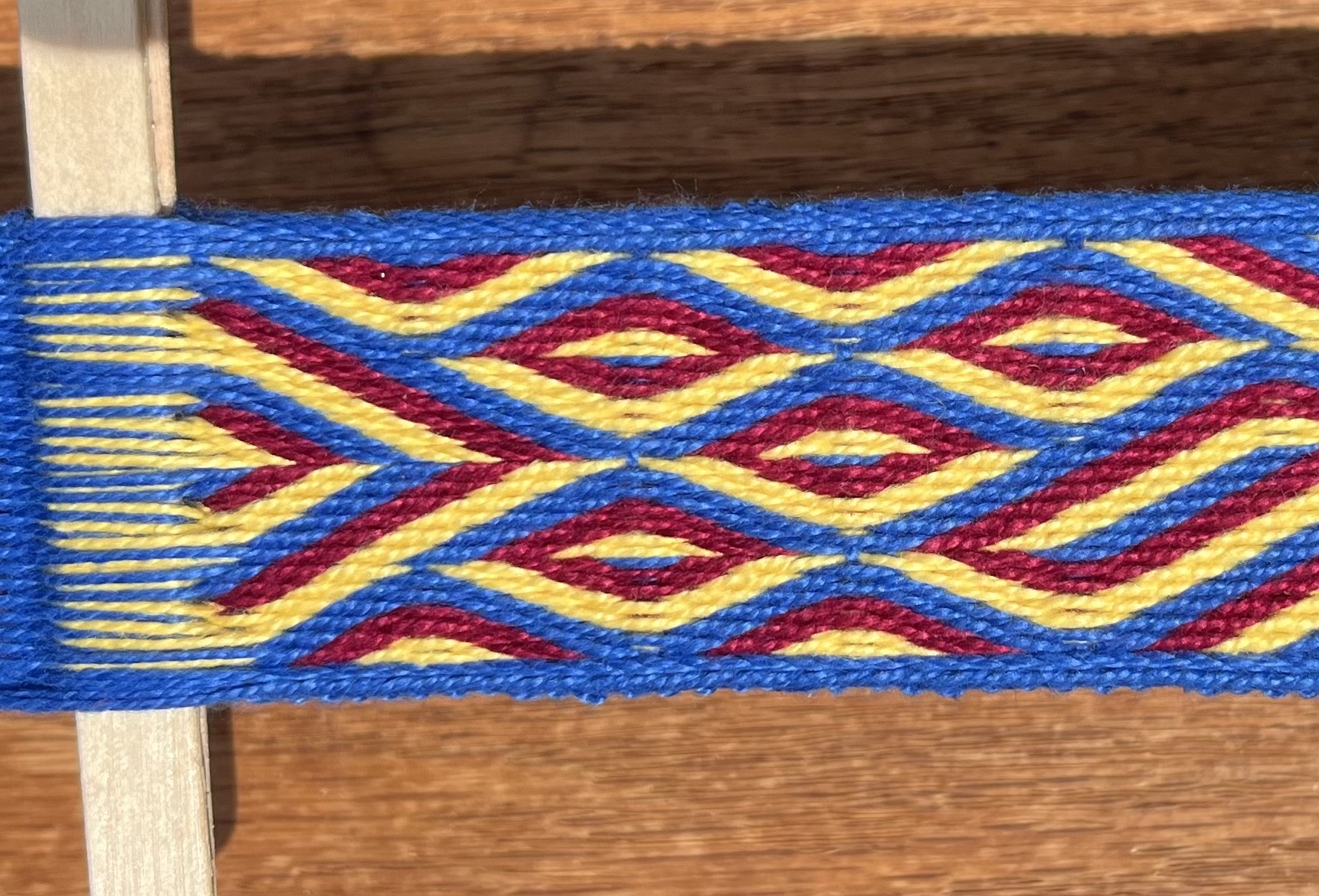So you rushed out and bought some weaving yarn, right? (Any excuse for stash enhancement, right, and “Phiala told me to!” has been used in the past to good effect.) If you bought something on a cone or ball, then you can skip all of the steps on the rest of this page. But read them anyway, okay? Eventually you’ll need to do this to some other yarn. If you are a knitter, you’ll probably need this information a lot.
You’ve got this skein of yarn, yes? That’s a good shape for storing yarn, because it doesn’t put any stress on it, but if you try to work from it you will get a tangly nasty mess. Trust me, don’t try it! That skein needs to become a ball.
If you do this a lot, an umbrella swift and ballwinder are good investments (more on that later), but this is primarily about the low-equipment approach.
Take that skein, slip the paper band off if it has one, and save that band for your notes. Some day you will want to know what kind of yarn you made that lovely project from, and there in your notes will be the ball band and all the information about your project, and your friends will be so impressed! Or, if you’re more like me, you will throw the ball band into a basket of yarn with the best of intentions, and it will still be there years from now. But we won’t talk about that.
Open out the skein into a circle. You need to have it under a bit of tension, so put it over two chair backs, a pair of C-clamps on a table, or the hands of a random passer-by willing assistant. There will probably be a knot joining the two ends, and possibly some other knots or even separate short pieces of string tied around the skein at intervals. The ends need to be untied. If you are positive any other ties are separate bits of string, then you can cut them, but better to untie if there’s any doubt. You really don’t want to be making your skein into skeinlets.

Having the skein under tension and with something in the middle (hands, chair, whatever) to keep the separate loops from getting tangled is very, very important. If you just drop it on the table and try to unwind it, you will get a mess. Same if you try to do it without any help, by sticking one hand into the skein to hold it open and using the other to unwind. Don’t try it, unless you already know that string really likes you.
Once you’ve got a skein support, you also need something to wind it onto. An old paper towel tube works beautifully, and gives you the advantage of a strong hollow core, kind of like on a cone of yarn. When we get to warping, you’ll see how this is an advantage.

The “professional” piece of equipment is an umbrella swift. It clamps to a table, will expand to hold any size skein (within reason), and spins freely to make unskeining much easier. Unfortunately even the cheap plastic ones like mine are close to $50, so it isn’t worth purchasing one unless you are going to be doing a lot of work with yarn.

If you are a knitter, or don’t otherwise don’t need the yarn in a cone, you can wind a center pull ball from your skein pretty easily. Start by running a figure-eight around your thumb and fingers a few times. Leave a long tail hanging down so you can find it again at the end. (This is also the beginning of what’s called a “yarn butterfly”.)

Once you’ve made five or six wraps, take the figure eight off your hand and fold it in half to make the center of your ball. Hold it along your thumb, and start wrapping the yarn around your thumb and the half-eight.

Every few wraps pull your thumb out and let those wraps join the main ball, then start wrapping over your thumb again. The thumb thing is to keep you from wrapping too tightly and distorting your poor defenseless yarn.
After the yarn starts to look like a ball instead of a shapeless blob, then you can start wrapping in a neat spiral, like you see on commercial balls. If you can’t do that, don’t worry too hard. Just try to make sure the ball stays fairly even, and try to keep the long starting end showing somewhere.
At the end, take the last bits of the skein and wrap them around the equator of the ball, then tuck the end underneath those last wraps to anchor it. If all went well, the long starting end is now the pullable center of your center-pull ball.
The fancier way to do it is to invest in a ball-winder like this one. Again, this is the cheap plastic model but still close to $50. Pretty much any yarn store online or off should be able to sell you this and the umbrella swift in the plastic and fancier wood models. The yarn runs straight from the swift to the ballwinder, so cranking the winder will make the swift unwind the skein for you.

See the nice spiral pattern on the ball? You can do the same thing by hand. It makes the ball nice and even.

Ball-winder balls are more like “yarn-cakes” than round balls. That’s okay, since it keeps them from rolling away when you pull warp off them (and makes them less attractive to cats). There’s also a fairly large center hole in the ball, unlike the hand-wound version.

Okay, enough preparation. You’ve got some yarn, you’ve made it into a useful form – next, an introduction to weaving! (Hooray, making stuff with string!)






3 responses to “Getting your string in shape”
The other day I was trying (unsuccessfully) to find an online picture of the Oseberg swift, but I came across this page: https://www.knittingnotionsonline.com I wonder if they know?
Good info. I’m wondering if you mean, by “weaving yarn”, that we need to get “hard twist” yarn? If so, where do we get it?
Also, a great idea you may not know about, is my friend Jen (folkcat) came up with a yarn swift, made from . . . . Tinker Toys!!! It adjusts to many sizes, including sizes for amounts of yarn too small for other swifts. It assembles and disassembles easily. She says it turns easily, although if she’s going to be using it alot for awhile, she can lube it with a little graphite or something to reduce wear. It fits in a zip-loc; here’s the link to her post about it, with pictures and instructions. This is what I am going to do for a swift, and my woodworker dad might be making me a ball winder, if I’m lucky!
Sarebear,
Not “hard twist” necessarily, although soft & fluffy is not good warp yarn. There are some suggestions in my earlier post in this series:
https://stringpage.com/blog/?p=44
I haven’t put a list of suppliers up – there are many good places to acquire weaving yarn, starting with your local yarn store, if you are lucky enough to have one. I will probably end up listing my favorite online sources eventually, though, and asking for comments and suggestions for others.